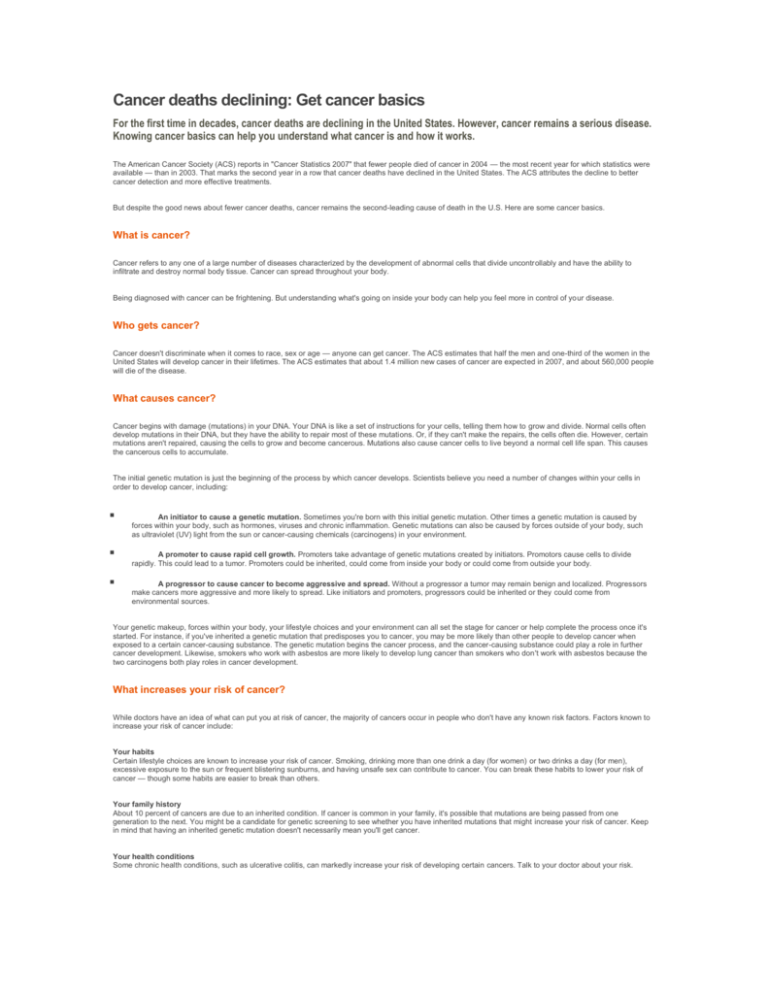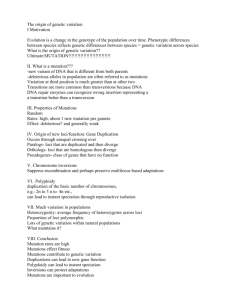Cancer deaths declining: Get cancer basics
advertisement

Cancer deaths declining: Get cancer basics For the first time in decades, cancer deaths are declining in the United States. However, cancer remains a serious disease. Knowing cancer basics can help you understand what cancer is and how it works. The American Cancer Society (ACS) reports in "Cancer Statistics 2007" that fewer people died of cancer in 2004 — the most recent year for which statistics were available — than in 2003. That marks the second year in a row that cancer deaths have declined in the United States. The ACS attributes the decline to better cancer detection and more effective treatments. But despite the good news about fewer cancer deaths, cancer remains the second-leading cause of death in the U.S. Here are some cancer basics. What is cancer? Cancer refers to any one of a large number of diseases characterized by the development of abnormal cells that divide uncontrollably and have the ability to infiltrate and destroy normal body tissue. Cancer can spread throughout your body. Being diagnosed with cancer can be frightening. But understanding what's going on inside your body can help you feel more in control of your disease. Who gets cancer? Cancer doesn't discriminate when it comes to race, sex or age — anyone can get cancer. The ACS estimates that half the men and one-third of the women in the United States will develop cancer in their lifetimes. The ACS estimates that about 1.4 million new cases of cancer are expected in 2007, and about 560,000 people will die of the disease. What causes cancer? Cancer begins with damage (mutations) in your DNA. Your DNA is like a set of instructions for your cells, telling them how to grow and divide. Normal cells often develop mutations in their DNA, but they have the ability to repair most of these mutations. Or, if they can't make the repairs, the cells often die. However, certain mutations aren't repaired, causing the cells to grow and become cancerous. Mutations also cause cancer cells to live beyond a normal cell life span. This causes the cancerous cells to accumulate. The initial genetic mutation is just the beginning of the process by which cancer develops. Scientists believe you need a number of changes within your cells in order to develop cancer, including: An initiator to cause a genetic mutation. Sometimes you're born with this initial genetic mutation. Other times a genetic mutation is caused by forces within your body, such as hormones, viruses and chronic inflammation. Genetic mutations can also be caused by forces outside of your body, such as ultraviolet (UV) light from the sun or cancer-causing chemicals (carcinogens) in your environment. A promoter to cause rapid cell growth. Promoters take advantage of genetic mutations created by initiators. Promotors cause cells to divide rapidly. This could lead to a tumor. Promoters could be inherited, could come from inside your body or could come from outside your body. A progressor to cause cancer to become aggressive and spread. Without a progressor a tumor may remain benign and localized. Progressors make cancers more aggressive and more likely to spread. Like initiators and promoters, progressors could be inherited or they could come from environmental sources. Your genetic makeup, forces within your body, your lifestyle choices and your environment can all set the stage for cancer or help complete the process once it's started. For instance, if you've inherited a genetic mutation that predisposes you to cancer, you may be more likely than other people to develop cancer when exposed to a certain cancer-causing substance. The genetic mutation begins the cancer process, and the cancer-causing substance could play a role in further cancer development. Likewise, smokers who work with asbestos are more likely to develop lung cancer than smokers who don't work with asbestos because the two carcinogens both play roles in cancer development. What increases your risk of cancer? While doctors have an idea of what can put you at risk of cancer, the majority of cancers occur in people who don't have any known risk factors. Factors known to increase your risk of cancer include: Your habits Certain lifestyle choices are known to increase your risk of cancer. Smoking, drinking more than one drink a day (for women) or two drinks a day (for men), excessive exposure to the sun or frequent blistering sunburns, and having unsafe sex can contribute to cancer. You can break these habits to lower your risk of cancer — though some habits are easier to break than others. Your family history About 10 percent of cancers are due to an inherited condition. If cancer is common in your family, it's possible that mutations are being passed from one generation to the next. You might be a candidate for genetic screening to see whether you have inherited mutations that might increase your risk of cancer. Keep in mind that having an inherited genetic mutation doesn't necessarily mean you'll get cancer. Your health conditions Some chronic health conditions, such as ulcerative colitis, can markedly increase your risk of developing certain cancers. Talk to your doctor about your risk. Your environment The environment around you may contain harmful chemicals that can increase your risk of cancer. Even if you don't smoke, you might inhale secondhand smoke if you go places where people are smoking or you live with someone who smokes. Chemicals in your home or work environment, such as asbestos and benzene, also are associated with an increased risk of cancer. How does cancer grow? Normal, healthy cells in your body grow in a very orderly and well-controlled way, living for a set period of time and then dying on schedule. When a normal cell dies, your body replaces it with another normal cell. Cancer cells grow in an uncontrolled manner. They forget to die and therefore the diseased cells accumulate. One malignant cell becomes two, two become four, four become eight, and so on, until a mass of cells (a tumor) is created. Tumors remain small until they're able to attract their own blood supply, which allows them to obtain the oxygen and nutrients they need to grow larger. Not all tumors are cancerous, and not all cancers form tumors. For example, leukemia is a cancer that involves blood, bone marrow, the lymphatic system and the spleen, but doesn't form a single mass or tumor. Cancer can also spread (metastasize) and invade healthy tissue in other areas of your body. Cancer can take decades to develop. By the time a cancerous mass is detected, it's likely that 100 million to 1 billion cancer cells are present, and the original cancer may have been dividing for five years or more. What does cancer look like? CLICK TO ENLARGE What does cancer look like? The only way to diagnose cancer is to examine the cells under a microscope. Some imaging tests, such as computerized tomography (CT) or mammography, can indicate the possible presence of cancer by showing an abnormal mass, but cancer can be definitively diagnosed only by looking closely at the cancer cells under a microscope. Your doctor uses a surgical process called a biopsy to get a sample of suspect tissue. Under the microscope, normal cells look uniform, with similar sizes and orderly organization. Cancer cells look less orderly, with varying sizes and without apparent organization.









